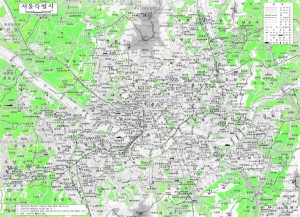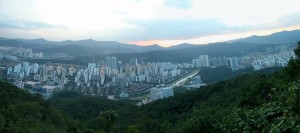By Winston Chang
Part I: The Promises of Transportation and its Impact on the Growth of the City
The population of Seoul grew tremendously in 1975, peaking at 6.8 million. With the population growing at such a large rate, the Korea Plan Association decided to create a greenbelt around Seoul’s satellite cities, an idea that was popularly used in the United Kingdom. The Green Belt Policy has served as a containment policy, to slow down massive sprawl in surrounding metropolitan areas such as Bundang. However, a Green Belt Reform process was formed, offering to change this restriction and to allow residents to move out of the densely populated city of Seoul. Bundang today is an ideal example of a suburban town of Seoul that has flourished and helped the economy of both Seoul and Bundang through facing the challenges of overcoming policies through the Greenbelt Reform.

“Ecology and Society: Urban Containment Policies and the Protection of Natural Areas: The Case of Seoul’s Greenbelt.” Ecology and Society: Urban Containment Policies and the Protection of Natural Areas:
Map of Green Belt Policy Restrictions
The 1975 Green Belt area was called the “Development Restriction Zone,” restricting urban sprawl. There were many other purposes that existed alongside with the restriction of urban sprawl. The government feared expansion to the North of Seoul for security reasons with North Korea. There were also environmental and agricultural preservation reasons. Seoul’s Green Belt extended 15km away from City Hall, and was later extended at an area of 86.8 kilometers squared (Jeon).

“On Infrastructure Architecture.” On Infrastructure Architecture. N.p., n.d. Web. 16 Dec. 2013.
A Closer look into the Green Belt Restrictions
Many problems existed with this Green Belt Policy, and its effectiveness was questioned. Firstly, the boundaries that were selected were strictly political decisions, not using any sort of land use survey or analysis to pick out this land. Additionally, the highly condensed city of Seoul has tremendously raised land prices, with many residents unable to afford housing costs. These issues all lead to the urban containment mitigation process, also known as The Green Belt Area Act. The process began through the guidance of The Ministry of Construction and Transportation, Seoul, Incheon, and Gyeongi-Do. The plan established zones for urban growth, where ratios would be established for these green belt areas. This way, the land and population could be assessed and each green belt area would be determined through a closer analysis. With these intentions in mind, the government predicted a tremendous change in housing prices, which would ultimately benefit both Seoul and the surrounding suburbs like Bundang.

“Thread: Bundang- Yes, No? Finding Own Apt?” Bundang- Yes, No? Finding Own Apt? N.p., n.d.Web. 16 Dec. 2013.
Bundang Today and its success as a highly residential suburb of Seoul
Bundang is an ideal example of a city that successfully resulted through looser urban containment policies. Although Bundang is a relatively new city, this artificial city has brought forth positive outcomes that can be labeled more so as the expansion of the city of Seoul rather than a fearful decentralization from the center city. Transportation has been key to make commuting from Seoul to Bundang much easier. Additionally, the condensed space of Seoul has been alleviated through the expansion to Bundang. Many people sprawled to cities outside of Seoul because of high housing rates; however, housing rates in Bundang today are almost just as high as it is in Seoul. This is because the Bundang has developed as Seoul’s major satellite city, and the convenience experienced by Bundang residents has made the district very popular. Additionally, Bundang is a strictly residential area, constructed with mainly apartment complexes (Song).
As the demand for residence continues to grow in Bundang, the district still expects to expand. Bundang, one of the most successful suburbs of Seoul, should be looked upon as a model for all other areas that were oppressed by the green belt policy. Although suburban sprawl in many cases can be deleterious for major cities like Seoul, observing the success of Bundang can give us a positive outlook on sprawl.
References
Jeon, Jae Sik. “The Effect of Green Belt Policy Reform on the Seoul Metropolitan Area Housing Market.” ACSP 53rd Annual Conference. University of Maryland, Web.
Song Young-bae. “Influence of New Town Development on the Urban Heat Island – The Case of the Bundang Area.” World Cat. 2005. Web. 23 Oct. 2013. <http://cornell.worldcat.org/title/influence-of-new-town-development-on-the-urban-heat-island-the-case-of-the-bundang-area/oclc/440055585&referer=brief_results>.
